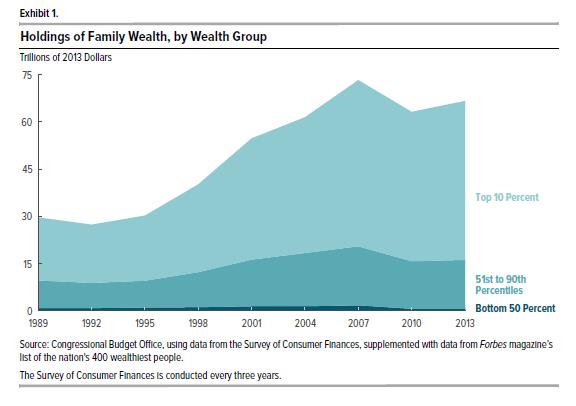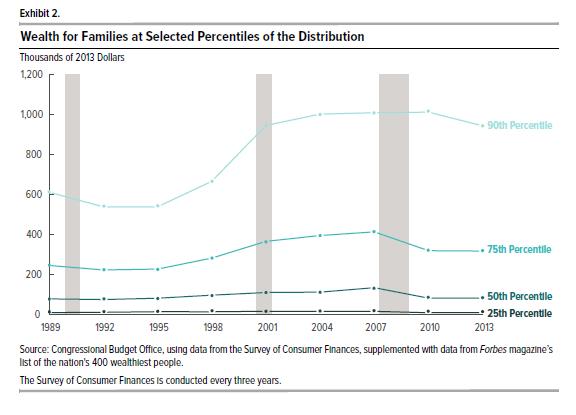What Gets Lost in the Income Inequality Debate
Recently, the Congressional Budget Office published an interesting study – “Trends in Family Wealth, 1989 to 2013.”
The main findings of the study can be summarized in a few points:
- Wealth inequality has increased between 1989 and 2013 (more on this below)
- The latest recession (2007-2009) hurt the wealth of most families, but especially those at the bottom of the wealth distribution
- Education matters – the higher the educational attainment of the person heading the family, the higher the family wealth (no surprise here)
- Wealth is accumulated over time – family wealth rises with the age of the person heading the family (again, not a surprise)
However, the most interesting insight from this report is that while the richest Americans are getting richer, that’s not the whole story.
To understand what this means, let’s look a little deeper at the data.
The study uses data from the Survey of Consumer Finances, a triennial survey of U.S. families sponsored by the Federal Reserve. The survey collects information about various financial matters, including peoples’ access to bank accounts and credit cards, their financial assets and non-financial assets (home equity and business equity, for example), the debt they carry, and their income.
Based on this information, the CBO constructed their measure of wealth as “marketable wealth, which consists of assets that are easily tradable and that have value even after the death of their owner.”
This excludes one important source of financial resources many families have – Social Security benefits and defined benefit pensions. (Not many families have defined benefit pensions these days, but quite a few receive Social Security benefits, either retirement or disability.) Because these things do not have value after the death of their owner, they are not included into the measure of wealth.
But they may constitute a significant share of financial resources: Just imagine what Social Security benefits (retirement or disability) mean to a low-income household that holds few, if any, other assets. This likely goes a long way to explaining how families in the bottom 25 percent of wealth distribution survive, despite the fact that their average wealth is negative throughout the period studied.
The CBO measures wealth as assets minus debt, which is the right way to go. Debt includes “nonmortgage debt, including credit card debt, auto loans, and student loans, for example.” Mortgage debt is not subtracted because on the asset side only the home equity (not the gross value of the home) was counted.
Here is the chart from this study that is likely to gain the most attention:
Most people would interpret this chart as showing the rich are getting richer. And it would appear that way. In 1989, the top 10 percent of earners owned 67 percent of the wealth. By 2013, that grew to 76 percent.
Well, it turns out there is another way to describe it, or at least a more nuanced view of it. The heart of the matter is in the phrase that CBO put in parentheses next to the chart: “Families in the top 10 percent of the wealth distribution in 2013 were not necessarily the same as those in the top 10 percent in earlier years.”
When looking at charts like these, people commonly make the assumption that “the rich” on top of the distribution are the same people throughout. But, of course, they are not.
Here is an example to drive the point home. Mark Zuckerberg is one of the very rich people today. What do you think his wealth was in 1989? Given that he was born in 1984, there was no such thing as “his wealth” in 1989. He was part of a family that fell somewhere on the wealth distribution, but it was definitely not in the same place of the distribution that he occupies today.
Zuckerberg might be an extreme example, but it illustrates a general point – the distribution of wealth and income does not stay static over time. There is at least some amount of churn, changing who is “on top” at any given time. At least in the case of income, people have tried to describe this churn. For example, this study uses a very large data set to describe what happens to the income of top earners (top 10 percent, top 1 percent, and top 0.1 percent of income distribution over time). When I saw an early presentation of this research at a conference in 2014, the authors emphasized that the turnover at the top of the income distribution was significant from year to year.
Wealth distribution is probably a bit more stable than income distribution, but there is some turnover there as well. I remember a story in 2009 about John McAfee, the founder of the McAfee software (you probably have their anti-virus software on your computer), which reported that he had lost most of his $100-million fortune and was reportedly worth only $1 million. Now, $1 million would still put him in the top 10 percent of wealth distribution, but the point here is that even a $100-million fortune can disappear in a few years.
So, here is a side note to interpreting charts like the one above that you do not hear often. It does NOT mean that “those who were rich to begin with will remain rich forever.” Some will, but some won’t. What is does mean is “Those who ended up being rich in the end (in 2013) were a lot richer than the rich people before them.”
Maybe this is not a surprise: Those who ended up on top of the wealth distribution in 2013 had to outdo those who were on top before them.
This interpretation also illuminates one more chart from the CBO report:
One might interpret this chart as saying that the wealth of those in the 90th percentile was not hurt in the latest recession, but the wealth of everyone else was. But that is not the case (and the story of John McAfee is only one example of this). What the chart does say is: Those who somehow managed to protect their wealth from the effect of the latest recession stayed in the 90th percentile (or rose to it), but those whose wealth was damaged significantly by the recession fell to lower percentiles.
There is no hereditary entitlement that once you get to the 90th percentile of the wealth distribution, you can never fall from it. People can, and do, move down the wealth distribution. And they can, and do, move up.
Click here to sign up for the Daily Economy weekly digest!










